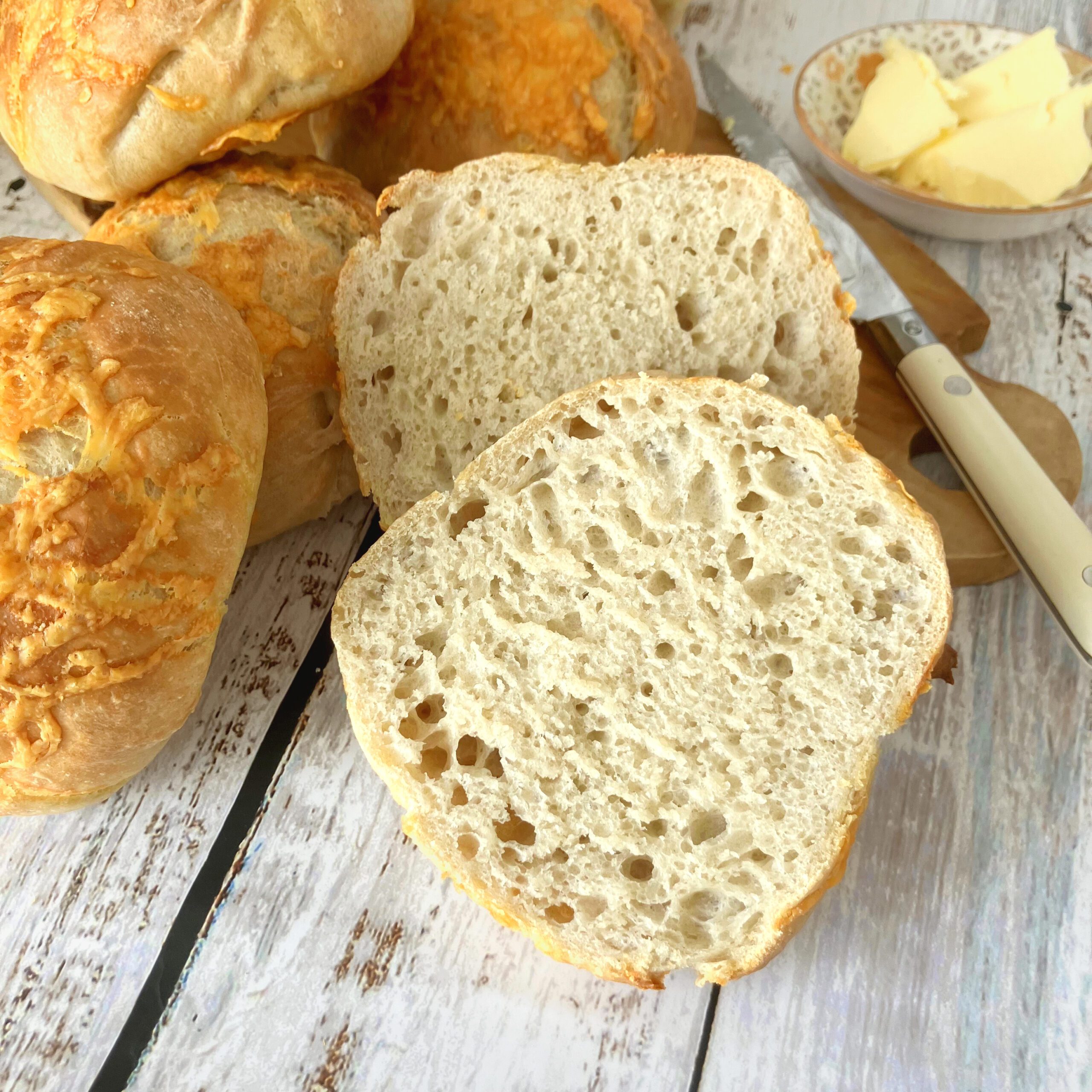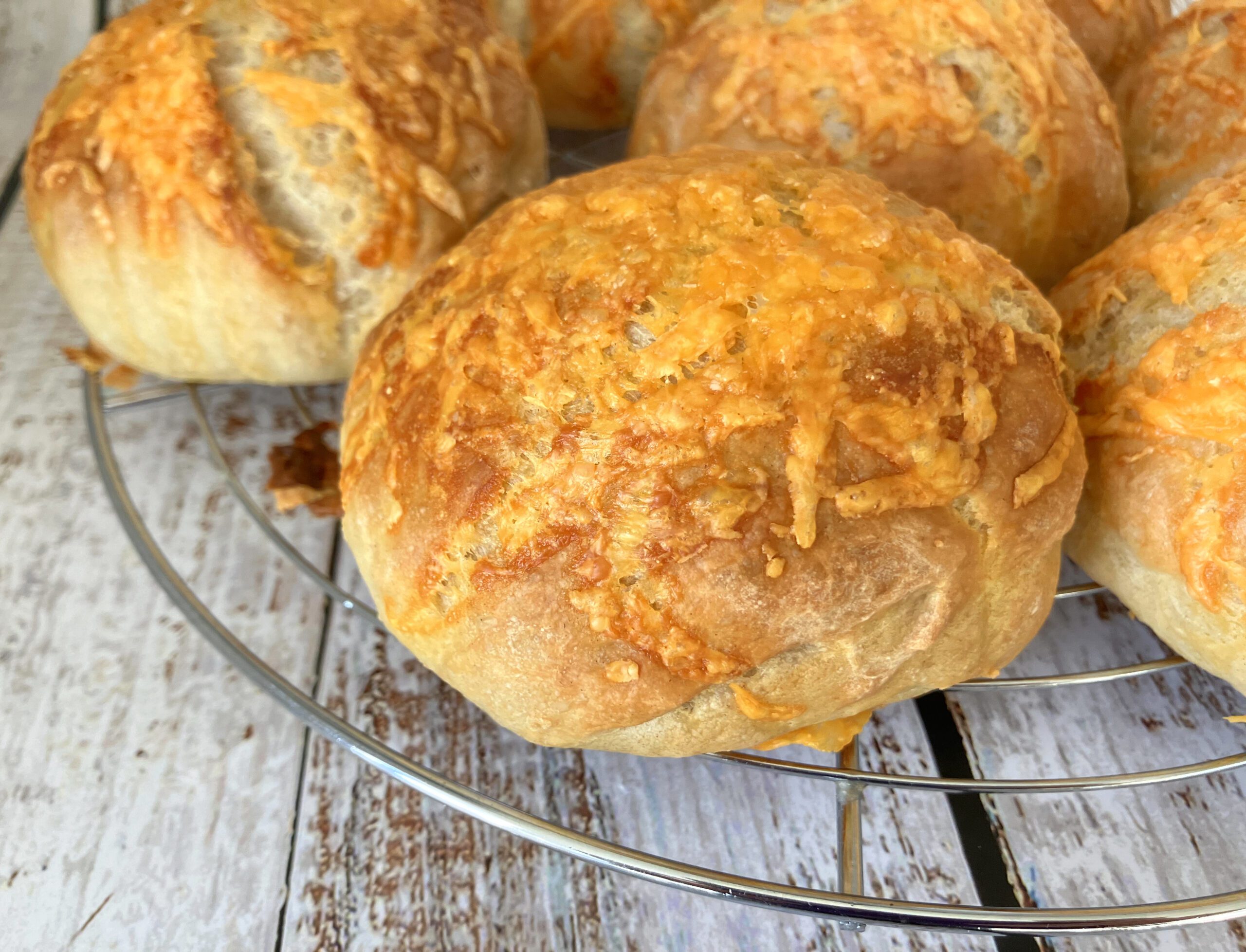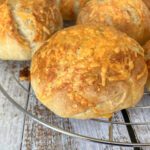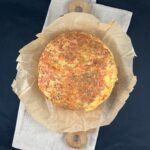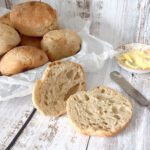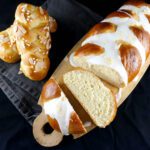No-Knead Spelt Cheese Buns
These soft, airy spelt cheese buns are a delightful twist on traditional Swedish frallor. They feature a tangy cheddar cheese topping that adds a rich, savoury finish. Made using the kalljäst method, the dough rises slowly in the fridge overnight. This gives the buns a light, airy texture and a subtle depth of flavour.
The recipe calls for just a handful of ingredients: flour, yeast, water, a pinch of salt, and, of course, a generous amount of cheddar cheese for the topping. Whether you enjoy them fresh out of the oven or freeze a batch for later, these buns offer the perfect combination of simplicity and deliciousness.
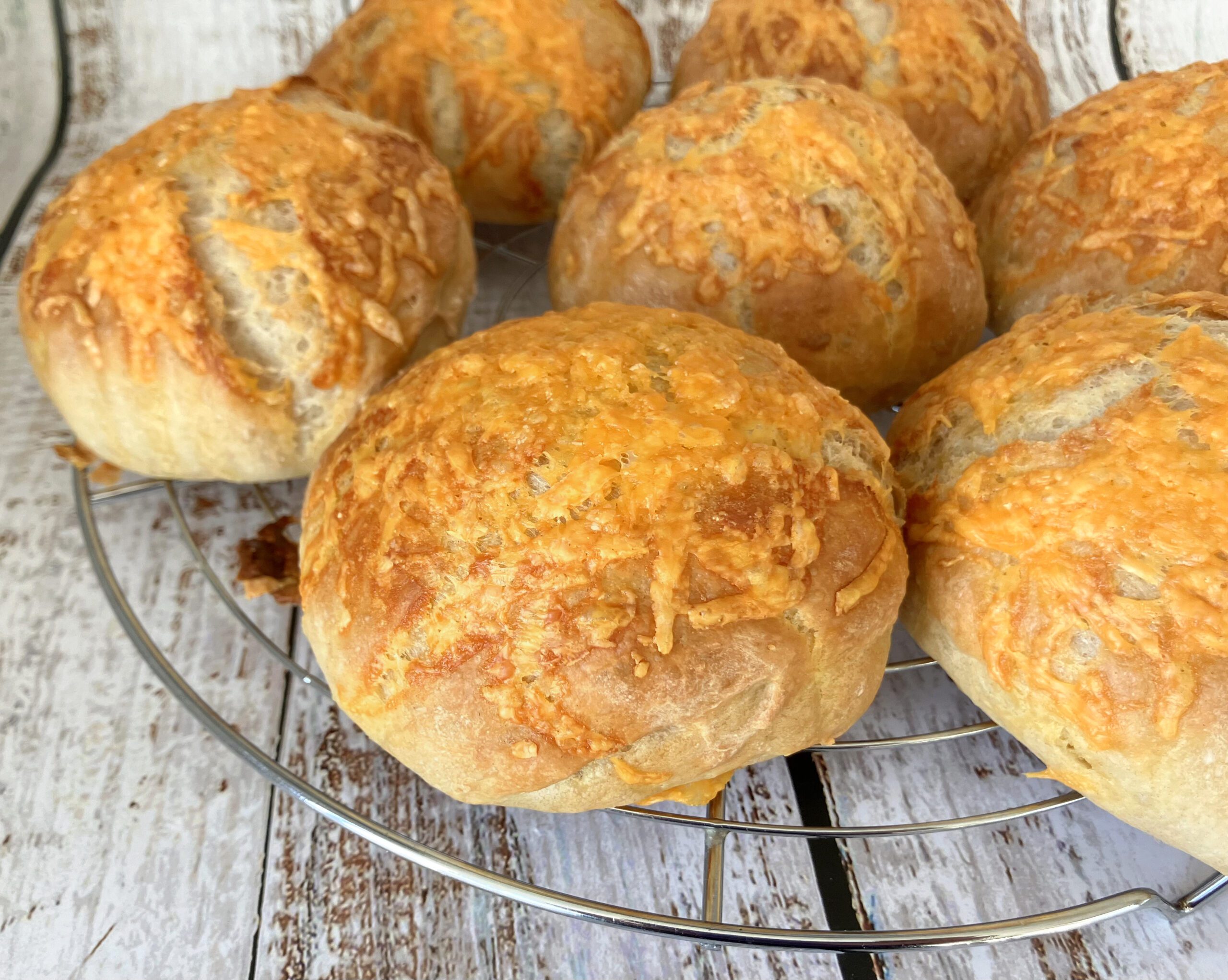
|
|
| Buns with a cheesy twist |
| Swedish cheese buns (ostbulle) |
| Cold proofing dough (kalljäst) |
| No-knead bread buns |
| Cheddar cheese topping |
| Adapting the recipe |
| More spelt bread recipes |
Buns with a cheesy twist
Frallor are soft, airy Swedish bread rolls with a slightly crisp crust. They are typically enjoyed at breakfast or as part of a light lunch. My recent frallor recipe impressed me so much that I wanted to give it a new twist. This time, I topped them with tangy cheddar cheese, creating what might just be my new favourite bread.
And yes, I know I say that every time I come up with a new recipe; but this one truly earns its place. With a no-fuss, no-knead overnight dough that calls for just a handful of ingredients, it’s as simple as it is satisfying. The texture is beautifully chewy and airy, reminiscent of sourdough, but without any of the upkeep. And let’s not forget the cheddar cheese topping, which adds a punch of flavour and takes this loaf to an entirely new level. It’s the kind of bread you’ll want to make again and again.
Swedish cheese buns (ostbulle)
Cheese-topped buns, or ostbulle, are a popular treat in Sweden. They are often enjoyed as a savoury snack or part of a light meal. The combination of soft, fresh bread and melted cheese is a beloved comfort food. You’ll often find these buns at bakeries or cafés across the country.
Swedes are known for their love of cheese. Pairing it with warm, fluffy bread is a match made in heaven.
Cold proofing dough (kalljäst)
These cheese buns use the kalljäst method, which translates to cold proofing (or cold fermentation). This technique involves letting the dough rise slowly in the fridge overnight. The extended rise enhances both the flavour and texture of the bread, resulting in a light, airy crumb with a subtle depth of taste.
This method isn’t just limited to cheese buns. It’s commonly used in many other Swedish baked goods to achieve a delicate, flavourful result. For example, Swedish cinnamon buns benefit from a cold rise, allowing the dough to develop a tender texture and a more complex flavour. Even Swedish rye bread and rich saffron buns often use kalljäst to create a soft crumb and enhanced taste. So, whether you’re making these cheese buns or experimenting with other Swedish treats, the cold rise adds a unique, enhanced quality to the dough, giving you consistently delicious results
If you are new to making bread, have a read of the ultimate guide to proofing dough, which is packed full of useful information.
No-knead bread buns
These cheese spelt buns require no kneading, which is actually key to achieving their light texture. However, it’s not just about avoiding kneading: the real trick is handling the dough gently to preserve its airy structure and create those characteristic holes, similar to sourdough.
Kneading is important in traditional bread-making because it helps develop the gluten in the dough, which provides structure, elasticity, and texture. As you knead, you’re stretching and folding the gluten proteins, forming a network that traps air produced by the yeast. This network allows the dough to rise and results in a chewy, airy texture with a good crumb.
Kneading also ensures the even distribution of ingredients like yeast, water, and salt, promoting a uniform rise. In classic bread-making, kneading can be a bit of a workout, but it’s essential for the right texture. However, in no-knead recipes, like this one, a slow fermentation process (often overnight) allows the gluten to develop naturally, so you can skip the vigorous kneading while still achieving a great texture. This simple, hands-off method lets you enjoy the process without stress, resulting in fresh, homemade buns with a light interior and a crispy crust. Perfect for beginners or anyone craving warm, easy-to-make rolls.
Cheddar cheese topping
For these cheese spelt buns, I love using my favourite cheddar cheese, which adds a rich, tangy flavour that perfectly complements the soft, airy dough. The sharpness of the cheddar gives the buns a delicious, savoury finish that’s simply irresistible when baked to a golden crisp. Plus, the vibrant orange of the cheddar cheese looks absolutely gorgeous once it’s melted and baked, giving the buns a beautiful, appetising finish.
However, feel free to experiment with other cheeses depending on your preference or what you have on hand. A good melting cheese, such as mozzarella, Gruyère, or even a creamy brie, would all work beautifully in this recipe. For a more intense flavour, try using Parmesan or a mature Gouda. If you’re after a slightly different twist, a blue cheese like Roquefort or Stilton can add a bold, tangy kick.
The possibilities are endless, so you can tailor the flavour to your liking or create a cheese blend that suits your taste. I didn’t bother measuring the cheese, just went with my heart, adding as much as I felt would give the buns the perfect cheesy topping.
Adapting the recipe
While this recipe yields 8 large cheese buns, you can easily adjust the size to suit your preference. If you prefer smaller buns, simply divide the dough into more portions. Around 12 or 16 smaller buns would be perfect for a gathering or if you want a lighter serving. The size is completely up to you.
These buns freeze wonderfully, so I always make a big batch. I’ll snaffle one or two, and once they’re completely cooled, I pop them in the freezer. When I’m ready for one, I simply microwave it for a few seconds to defrost and lightly warm it, and they taste as fresh and delicious as when they were first baked.
In terms of flour, feel free to get creative with your choice. I use spelt flour for all my bread, which results in a slightly nutty flavour and a lighter texture. However, you can easily swap it out for regular all-purpose flour or even bread flour. If you opt for bread flour, you’ll get a slightly chewier texture and more structure in your buns. Each type of flour brings its own character, so don’t be afraid to experiment and find the variation you like best.
Wholegrain spelt & oat bread buns
No-Knead Spelt Cheese Buns
Ingredients
- 660g (5½ cups) spelt flour (see note 1)
- 7g (2¼ tsp) dried yeast (see note 2)
- 2 tsp salt
- 500ml (2 cups) warm water
- 1 tbsp olive oil
- cheddar cheese (see note 3)
Instructions
- In a large bowl, or stand mixer bowl, add the flour, yeast and salt, and mix to combine.
- Combine the oil and water together, then pour into the dry ingredients.
- Thoroughly mix the ingredients together, but there's no need to overmix.
- Cover the bowl with clingfilm and place in the fridge overnight (see note 4).
- When ready to bake, pre-heat the oven to 250℃ (482℉).
- Pour the dough out onto a well-floured surface. Cover the dough with more flour.
- Pat into a loose rectangle shape. Using a pizza cutter, dough cutter or sharp knife, divide the dough into equal pieces.
- Add a little flour to your hands and gently fold the edges underneath to shape them roughly (see note 5).
- The dough is very sticky and hard to move. Either add a little more flour to your hands or use a dough scraper to pick them up.
- Place them on a lined baking tray, leaving space between each. Let the buns rest for a little bit, just until the oven is hot enough.
- Bake for around 15-17 minutes, depending on size, but as it is a very hot oven, keep a really close eye on them. Your buns should be very brown but not burned.
- Allow to cool for at least ten minutes before eating. Any left over can be frozen. Enjoy!
Notes
You need to handle the dough carefully so as not to disturb the air bubbles that give the buns their light, fluffy middles. You do not knead it! 5. You don't need to do any shaping at all, and although you will need a little additional flour on your hands, try not to add any more to the dough. It's very sticky and meant to be.


